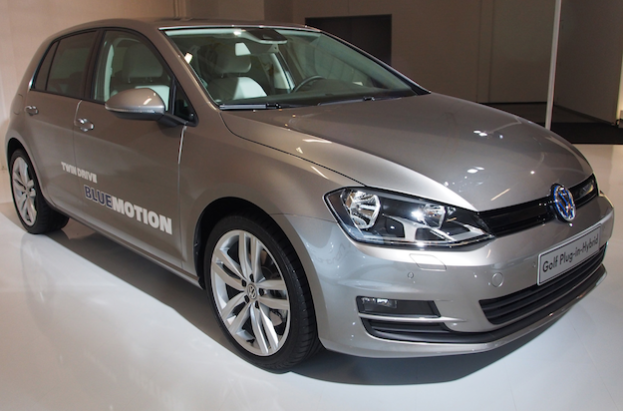
If you’re a Volkswagen fan, this is the week dreams are made of . The German automaker has given us a glimpse into several all-new Golf variants, each more exciting than the last.
Sadly, this onslaught of new German economical cars had to come to a close. Luckily for VW fans, it’s ending on a high note. We proudly present to you: the Golf Plug-In Hybrid.
Just like the e-Golf and GTD unveiled earlier this week, the Golf Plug-In Hybrid is based upon the brand-new Golf platform, the Mk 7.
According to an AutoCar report, the Golf Plug-In Hybrid shares the same electric motor as the Audi A3 e-tron, which was also unveiled earlier this week. In addition to its 100 horsepower electric motor, the Golf Plug-In Hybrid includes a 148-horsepower TFSI gasoline engine with a combined torque output of 256 pound-feet. The Euro test cycle estimates put the new VW plug-in hybrid’s fuel economy rating at 188 MPG. This is a bit higher than any EPA MGPe (miles-per-gallon equivalent) ratings we might see in the US, but it’s still very promising.
The Plug-In Hybrid Golf features a special hybrid transmission that mates the electric motor and gas engine together. Drivers can select three drive modes. Depending on the mode, the electric motor or gasoline engine can propel the Golf independently or in unison. The most exciting mode for us horsepower junkies is the “Boosting” drive mode where both powerplants are used to drive the Golf.
Just like the Volkswagen Jetta Turbo Hybrid we drove earlier this year, the Golf Plug-In Hybrid features a coasting feature that uses a clutch between the motor and transmission to quickly disconnect the drivetrain from the wheels at highway speeds as soon as the driver lets off the accelerator. This allows the Golf to cruise extremely efficiently as the gas engine shuts off and the vehicle makes use of its forward momentum.
For drivers less interested in power output, the Plug-In Hybrid will travel an adequate 31 miles in electric-only mode, which is on-par with a few plug-in hybrids currently on the market like the Chevy Volt.
Although we don’t yet know if the plug-in hybrid version of the Golf will be headed to the U.S., we’d be awfully surprised if it didn’t.
Editors' Recommendations
- Jeep’s plug-in hybrid Wrangler will silently prowl the great outdoors
- Lincoln Corsair Grand Touring adds plug-in hybrid power
- Sharp and tech-savvy, the Volkswagen Golf gets a full digital reboot
- Ferdinand Porsche was 100 years ahead of his time with his 1900 hybrid
- Mercedes downsizes its plug-in hybrid tech with the new A250e sedan, hatchback


